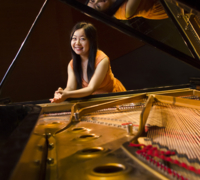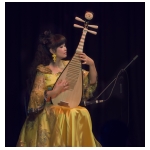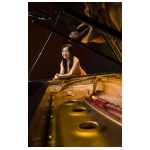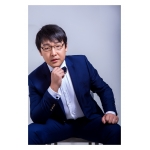27th May 2018 - Yellow River Concerto

In its first concert for 2018, the combined Manawatu Sinfonia and Manawatu Youth Orchestra will be conducted by Canwei Li in a performance of the Chinese classic 'Yellow River Concerto' and other items.
Our co-host and generous funding supporter is the China Cultural Centre in New Zealand.
Date: Sunday 27 May 2018, 2.30pm
Venue: Regent Theatre, Broadway Avenue, Palmerston North
Programme
WOLFGANG AMADEUS MOZART (1756-1791), Overture to Nozze di Figaro
WU TSU-CHIANG (1927-), Concerto for Pipa “Little sisters of the Grasslands”, with pipa soloist Min Gao
LUDWIG VAN BEETHOVEN (1770-1827), 6th Symphony (Pastoral)
XIAN XINGHAI (1905-1945), Yellow River Piano Concerto, with piano soloist Xing Wang
WOLFGANG AMADEUS MOZART (1756-1791), Overture to Le Nozze di Figaro (The Marriage of Figaro)
Mozart composed his opera “The Marriage of Figaro” in 1786. The first of three successful collaborations between librettist Lorenzo da Ponte and Mozart, this work was based on the second part of a trilogy by French playwright Pierre-Augustin Caron de Beaumarchais (1732-1799), continuing the story of Figaro that begins with The Barber of Seville. Beaumarchais’ play had been banned by King Louis XIV of France and other European rulers as poking fun at the aristocracy but in fact the aristocracy enthusiastically sponsored clandestine performances (one of which included the king’s wife).
Da Ponte and Mozart’s operatic treatment premiered in 1786 in Vienna but it was on tour in Prague in 1787 that its popularity first really declared itself. Mozart famously wrote, “The one subject of conversation here is Figaro; nothing is played, sung or whistled but Figaro; nobody goes to any opera but Figaro; everlastingly Figaro!”
This technically very demanding overture, which Mozart composed in characteristic haste, launches immediately into a running passage in the strings and bassoons. Played presto and pianissimo, it suggests the conspiratorial whispers and intrigue of the main characters and gives a sense of the frenetic, breathless pace of the action to follow. Mozart decided against writing a contrasting slow section, and the more lyrical second theme also pushes forward relentlessly.
WU TSU-CHIANG (1927-), Concerto for Pipa, “Little sisters of the Grasslands”, with pipa soloist Min Gao
Based on a true story that also inspired an opera, this concerto conjures up the heroism of two young sisters in Inner Mongolia. One day in the harsh winter of 1964 Longmei and Yurong, aged eleven and nine, were entrusted by their father to look after one of the collective farm’s flocks of sheep and keep them close to home while he went out to help his neighbours. The two girls instead drove the flock some distance to better pasture. A sudden blizzard panicked the sheep into a stampede. Faced with extreme cold, marauding eagles and wolves, and an opportunistic robber-baron, the two sisters fearlessly protected their sheep. Their steadfastness is a testament to their nationalism, their devotion to family livelihood, and the spirit of martyred hero Lei Feng.
The pipa, a traditional four-stringed lute-like instrument introduced to China two thousand years ago, can produce a multitude of different colours and sounds and is also capable of a wide range of musical styles. Technically most difficult is the right-hand tremolo, which has all five fingers continually strumming. Though brilliant in tone, the pipa needs amplification when played with an orchestra. “Little Sisters of the Grassland”, the first concerto for this instrument to be composed, was given its premiere by the Boston Symphony in Beijing in 1979. Although there is no native Chinese tradition of works for pipa in concerto form, this work strikingly showcases the traditional “lyrical” and “martial” playing styles characteristic of this instrument.
LUDWIG VAN BEETHOVEN (1770-1827), 6th Symphony (“Pastoral”)
Beethoven sketched out his Sixth Symphony on long refreshing walks through the countryside surrounding Vienna. The première took place at a marathon all-Beethoven concert in Vienna at the close of 1808.
Beethoven himself added the subtitle “Pastoral” and titled each movement to indicate country themes. At the same time, he emphasized that what mattered were “emotions, not sound-pictures”. As if to indicate how deep and fundamental these emotions are, he builds his musical plan on the simplest of harmonies, with prevalent use of major triads based on tonic, dominant, and subdominant. The diminished-seventh chord is withheld until the “thunderstorm” of the fourth movement.
In the same spirit, the first two movements are scored for unusually small forces of woodwinds, horns, and strings. The leisurely first movement, entitled “Awakening of Cheerful Thoughts Upon Arriving in the Country”, opens with a drone, imitating country bagpipes or musettes. Just before the close the solo clarinet performs a virtual cadenza of triplet arpeggios. In the second movement, “Scene by the Brook”, two muted solo cellos provide a background murmur along with second violins and violas, suggesting the stream, while the first violins and woodwinds contribute a rich array of turns and trills. Beethoven identifies in the score the contributions of the nightingale (flute), quail (oboe), and cuckoo (clarinets).
Played without pause, the final three movements gain increased drama and dynamic range as Beethoven adds trumpets, trombones, and piccolo. The scherzo, “Merry Gathering of Country Folk”, is a caricature of dances played by village bands, with a quirkily offbeat part for solo oboe. It is interrupted at its last chord by a dramatic “Storm” movement in F minor, the only point in the entire work where timpani are used. As the storm ends, a Swiss herdsman’s cow-call, or yodel, introduces the final movement (“Shepherds’ Song, joyful and grateful feelings after the storm”), where the symphony’s opening mood of serenity is restored.
XIAN XINGHAI (1905-1945), Yellow River Piano Concerto, with piano soloist Xing Wang
The Yellow River Piano Concerto is a collaborative arrangement by a group of musicians, including Yin Chengzong and Chu Wanghua, from the Yellow River Cantata by Xian Xinghai (1905-1945). Amongst the earliest Chinese composers to be influenced by western classical music, Xian Xinghai evolved a highly influential fusion of western forms and traditional Chinese folk melodies.
The cantata originated as a setting of a poem written in the midst of China’s struggle with Japan in the late 1930s. After the loss of the city of Whan to the Japanese in November 1938 the military leader and poet Guang Weiran (1913-2002) led his Communist Party troops across the Yellow River near Hukou Waterfall. There he chanced upon boatmen singing while battling against gales and mighty waves. So inspired was Guang Weiran by their indomitable spirit that he composed a patriotic poem in January 1939 and recited it during the Chinese New Year celebrations. His work, urging the Chinese to defend their country, spread through China as a call to arms.
The piano concerto arrangement, completed in the late 1960s, during China’s Cultural Revolution, evokes this story of the Yellow River, also known as the mother river of China. It contains four movements, entitled The Boatman’s Song, Ode to the Yellow River, Wrath of the Yellow River, and Defend the Yellow River.
Pipa soloist: Min Gao

Min Gao graduated from the China Conservatory of Music and is a member of the Chinese Musicians Association and the Chinese Performers Association. She has served as director of the Pipa Division of the Chinese National Orchestra Association and the Chief Chinese Lute Virtuoso for the Chinese Song and Dance Troupe. Her book 'Learning the Pipa from Step Zero' has been published by the Chinese Opera and Shanghai Conservatory of Music. As a representative of the National Song and Dance Troupe she has visited the US, France, Switzerland, Russia, Japan, South Korea and numerous other countries. In New Zealand, Min has collaborated with Pu Cuxin, given lectures on the Pipa at the Auckland Arts Festival 2017, and held an individual show at the Uxbridge Theatre.
Piano soloist: Xing Wang

Currently completing her doctoral studies with the NZSM (Victoria University of Wellington), Ms Xing Wang received her Bachelors and Masters degrees in performance with the Honor of the Piano Department Award from the San Francisco Conservatory of Music. Now living in Auckland, Ms Wang is one of New Zealand’s most sought-after pianists. She has appeared as soloist with the Auckland Philharmonia Orchestra, the NZSM Orchestra, and the Tawa Symphony Orchestra. She has given solo recitals around the globe, including China, the US, Spain, Italy, and New Zealand. Xing is also a passionate chamber musician. She and her colleagues founded the Auckland Piano Trio, and her ensemble will be part of the 2017 Chamber Music New Zealand Encompass Regional Tour series. Her performances have been very well received and many of them have been broadcast by Radio New Zealand.
Xing has won prizes in numerous competitions, including first place in the Mu Phi Epsilon Young Artist Competition (USA), the Sturm-Page Piano Competition (USA), the US Open Music Competition (USA), NZSM Concerto Competition (NZ), SIMF Concerto Competition (Italy), and Schumann Cup Piano Competition (China). She was runner-up in the Baisi Cup Piano Competition (China) and took fourth place in the international Hong Kong Mozart Piano Competition.
During her study in the United States, Xing served as music director in the San Francisco Grace United Methodist Church and accompanist and coach of the Ina Charles Opera Ensemble and the Capital Opera Company. She has participated as a fellow performer and teaching assistant in various music festivals including the Bowdoin International Music Festival in Boston, the Valencia International Piano Academy, the Siena International Music Festival, and the ASQ International Music Festival in Wellington.
Conductor: Canwei Li

Canwei Li was born in Taiyun, Shanxi Province, China, and moved to New Zealand in 2006. He started learning piano at age four and gave his first public piano performance at six in the Shanxi Drama and Opera Hall. He made his first television appearance at the age of ten, performing Beethoven and Chopin piano pieces. He received his formal musical education at The University of Auckland, where he majored in piano performance. He has since dedicated his career to conducting, teaching piano, and performing chamber music. In the past few years, Canwei has received instruction from and worked closely with many celebrated conductors such as Rita Paczian, Archim Holub, and Robert Gutter. He made his conducting debut with London Classical Soloists in August 2016. Since 2016 Canwei has also been the musical director of the ChaoShan Ensemble in Auckland, with four concerts a year at major venues such as the Auckland Town Hall and Bruce Mason Centre. In January 2017, Canwei made his debut conducting the Gwinnett Symphony Chamber Orchestra in Atlanta, Georgia. In the same year he commenced study under the tutelage of Maestro Edo de Waart and Hamish McKeich through the NZSO’s mentoring program. Canwei is very excited to be working with the Manawatu Sinfonia and is looking forward to May’s concert!
Next Concert
Sinfonia: Sunday 10th May at 2.30pm
Speirs Centre, Boys High
How to join
Click here for details on how to join the Manawatu Youth Orchestra or the Manawatu Sinfonia.
